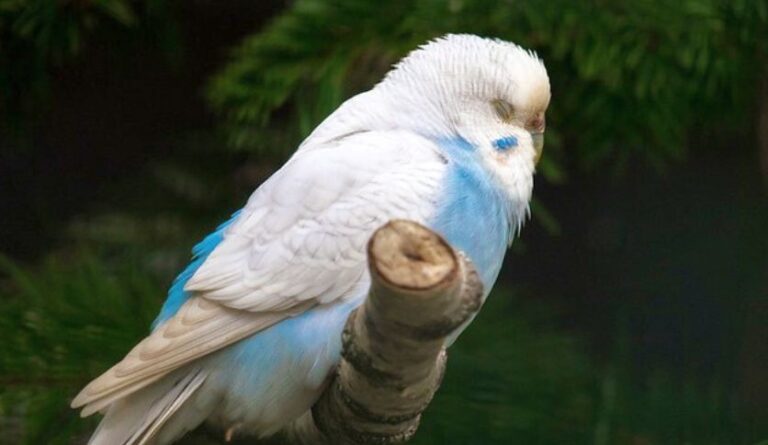Have you ever wondered, “Do parakeets need to be covered at night?” It’s a question that many parakeet owners ask, especially when they first welcome these colorful, chirpy birds into their homes. Parakeets, known for their playful nature and charming chatter, also have specific needs regarding their sleep environment. This article explores whether covering their cages at night is necessary for their well-being and what it means for these delightful feathered friends.
Whether you’re a seasoned parakeet parent or new to bird care, understanding the best practices for your bird’s nighttime routine is crucial for their health and happiness. Let’s dive into the world of parakeets and uncover the answer to this common query.
Understanding Parakeets
Parakeets, also fondly known as budgerigars, are charming little birds from Australia’s warm and somewhat dry areas. In their natural habitat, these birds have a unique way of living. They don’t just perch on any tree branch to sleep but seek out tree hollows. These hollows are special nooks in trees that provide more than a resting place. They offer safety from predators and harsh weather; they’re dark.
Why does this matter to us as parakeet owners? Well, it tells us a lot about what parakeets need to feel comfortable and secure, especially when it’s time to sleep. In the wild, the darkness of the tree hollows plays a big role in their sleep cycle. It signals to them that it’s time to rest and helps them get a good night’s sleep.
The Importance of Covering
When we tuck ourselves in at night, we often seek the comfort of a dark, quiet room. Surprisingly, our feathered friends, parakeets, crave a similar environment for their slumber. Covering a parakeet’s cage at night is more than just a routine; it’s about recreating the secure and dark conditions they naturally seek for a good night’s rest.
Parakeets find solace in the shadows of trees or cozy, dark nooks in the wild. This darkness is not just for comfort; it plays a crucial role in regulating their biological clock, known as the circadian rhythm. This rhythm dictates their sleep-wake cycle, and maintaining it is essential for their overall health.
When we cover their cages, we mimic these natural conditions. The cover acts like a signal, telling them that it’s time to wind down and rest. This is especially important in our homes, where artificial lights and everyday noises can disrupt their sleep patterns. Like us, a lack of proper sleep can make parakeets grumpy or even affect their health.
From my own experience, the difference a cover makes is quite remarkable. I’ve seen restless birds, who were once chirping or fluttering at the slightest sound, become calm as soon as their cage was covered. It’s as if the cover tells them they’re safe and it’s time to rest. This sense of security is vital for their well-being, as it helps them to relax and sleep without fear of predators or disturbances.
Benefits of Covering Parakeets at Night

When the sun sets and the house quiets down, it’s time for your parakeet to rest. But just like us, these little birds need the right environment to get a good night’s sleep. Covering their cage at night can be a game-changer for their well-being. Let’s explain why it’s beneficial and how to do it properly.
Creating a Cozy, Dark Environment
First off, covering the cage helps create a dark, cozy space for your parakeet. In the wild, parakeets are used to the darkness of the night, which signals it’s time to rest. By covering their cage, you’re mimicking this natural setting, helping them understand it’s bedtime. This darkness can be especially helpful in homes where lights might stay on late or where there’s a lot of outside light, like street lamps.
Reducing Distractions and Noise
Our homes are full of sounds and movements that can keep a sensitive parakeet awake or startled. The cover acts like a little shield, muffling noises from the TV, conversations, or even the hustle and bustle of late-night activities. It also blocks out sudden movements or shadows that might pass by their cage, which can be disturbing for them.
How to Cover the Cage Right
- Choose a Breathable, Light Cover: The cover you choose is important. It should be light and breathable. This means avoiding heavy blankets or thick towels. A light cotton sheet or a specially designed bird cage cover works best. The idea is to allow air to flow freely so your parakeet doesn’t get too hot or feel suffocated.
- Gently Drape the Cover Over the Cage: Do it gently when putting the cover on. Make it a calm and soothing process. Drape the cover over the cage, leaving a small area uncovered. This gap is crucial for ventilation. It ensures enough air circulation and gives your parakeet a comforting glimpse of their surroundings.
- Secure the Cover: Ensure the cover is secure but not too tight. You don’t want it to fall off in the middle of the night, which could scare your bird. But also, it shouldn’t be so snug that it restricts the cage’s doors or feeding areas.
The Vet’s Perspective
Many veterinarians who specialize in birds agree that covering the cage at night can do wonders for a parakeet’s health. It reduces their stress levels, which is important for their overall well-being. A stress-free parakeet is likelier to have a stable mood, better appetite, and a regular sleep pattern. All these factors contribute to a healthier, happier bird.
Alternative Methods and Considerations
Covering their cage is a widely recommended method to ensure a peaceful night’s sleep for your parakeet. However, it’s not the only way to create a comfortable sleeping environment for your feathered friend. Let’s explore some alternative approaches and important considerations to keep in mind.
Understanding Your Bird’s Environment
Firstly, consider the location of your parakeet’s cage. If the cage is already in a quiet and dark room, you might not need to cover it. Parakeets appreciate a calm and dimly lit environment for a good night’s sleep. So, a cover might be unnecessary if your bird’s room naturally provides these conditions as the sun sets.
Adjusting to Natural Light Cycles
Another aspect to consider is the natural light cycle. Parakeets are diurnal, meaning they are active during the day and rest at night. Aligning their sleep schedule with natural daylight and darkness can benefit their circadian rhythm. If your bird’s room gradually darkens as the evening progresses, this can signal to your parakeet that it’s time to wind down, mimicking their natural habitat.
Minimizing Disturbances
Sudden noises or lights can startle your parakeet even in a dark room. It’s important to minimize these disturbances. This could mean:
- Keep the room away from loud noises like TV or street traffic.
- Use blackout curtains to prevent sudden light flashes from cars or street lamps.
- Ensuring that family members know to keep the noise down near the bird’s room at night.
Creating a Consistent Routine
Parakeets thrive on routine. Whether you cover the cage or not, try to be consistent with your bird’s bedtime schedule. Consistency helps your parakeet feel secure and understand when it’s time to rest.
Monitoring Your Bird’s Behavior
Every parakeet is unique, and what works for one might not work for another. Observe your bird’s behavior closely. You might need to reconsider your approach if they seem restless or agitated at night. On the other hand, if your bird seems calm and sleeps through the night without a cover, you’re likely providing a suitable environment.
Common Mistakes to Avoid When Covering Your Parakeet’s Cage at Night
Caring for a parakeet is a delightful experience filled with learning and bonding. However, regarding their bedtime routine, there are a few common pitfalls that every parakeet owner should be aware of. Let’s talk about these mistakes so you can avoid them and ensure your feathered friend has a peaceful and healthy night’s sleep.
1. Using Heavy or Opaque Covers
One of the most frequent mistakes is using a cover that’s too heavy or completely blocks light and air. While it’s important to create a sense of darkness and security for your parakeet, remember that they still need good air circulation. Heavy or non-breathable materials can make the cage stuffy, which isn’t comfortable or healthy for your bird. Instead, opt for a light, breathable fabric. Think of it like choosing a blanket for yourself – you want something that feels cozy but doesn’t make you feel trapped or overheated.
2. Abrupt Changes in the Nighttime Routine
Parakeets, much like us, are creatures of habit. They thrive on routine and can become stressed or anxious with sudden changes. If you decide to start covering their cage at night, it’s crucial to introduce this change gently. Don’t just start in the blue. Instead, gradually ease your bird into this new routine. You might begin by covering the cage for short periods during the evening, gradually increasing the time until it becomes a part of their nightly routine. This gradual approach helps your parakeet adjust without feeling overwhelmed or scared.
3. Ignoring Your Bird’s Preferences
Just like people, every parakeet has its personality and preferences. Some might find a covered cage comforting, while others might dislike it. Pay attention to how your bird reacts. If they seem agitated or more vocal than usual after you start covering the cage, they might be trying to tell you they don’t like it. In such cases, reconsider whether covering the cage is the best option for your bird.
4. Forgetting to Consider Environmental Factors
The need to cover your parakeet’s cage can also depend on the environment in your home. If the room where you keep the cage is already quiet and dark at night, a cover might not be necessary. On the other hand, if the room has a lot of light or noise, a cover could be very beneficial. Always consider the specific conditions in your home and adjust your bird’s sleeping arrangements accordingly.
Frequently Asked Questions (FAQs) on Do Parakeets Need to Be Covered at Night
Is it necessary to cover my parakeet’s cage every night?
Covering the cage is not mandatory but can be beneficial. It helps mimic the darkness of their natural habitat, aiding in better sleep. However, whether you need to cover the cage depends on your bird’s preferences and the environment in your home.
What type of cover should I use for my parakeet’s cage?
Use a light, breathable fabric that allows air circulation while providing darkness. Avoid heavy or completely opaque materials that can restrict airflow.
Can covering the cage at night harm my parakeet?
If done correctly, covering the cage should not harm your parakeet. Ensure the cover is breathable and doesn’t completely block airflow. Also, gradually introduce the cover to avoid stressing your bird.
How do I know if my parakeet likes being covered at night?
Observe your parakeet’s behavior. They likely find the cover comforting if they seem calm and sleep well through the night. They may not like it if they appear agitated or stressed; you might need to reconsider.
How long should the cage be covered at night?
Ideally, cover the cage around your parakeet’s bedtime and remove the cover when you wake up, maintaining a consistent sleep-wake cycle. Parakeets generally need about 10-12 hours of sleep each night.
What should I do if my parakeet doesn’t adjust to the covered cage?
If your parakeet doesn’t adjust well, try a different type of cover, partially cover the cage, or skip the cover altogether. The key is to ensure your bird feels safe and comfortable.
Conclusion
In wrapping up our discussion on “Do parakeets need to be covered at night,” it’s clear that the answer isn’t a simple yes or no. It largely depends on your parakeet’s individual preferences and the environment in your home. Covering the cage can provide a sense of security and mimic the darkness of their natural habitat, potentially leading to a better night’s sleep. However, using the right cover type and gently introducing this change is crucial to avoid stressing your feathered friend.
Remember, each parakeet is unique. Pay attention to how your bird reacts to being covered at night and adjust accordingly. The ultimate goal is to ensure your parakeet feels safe, comfortable, and happy. By being attentive to your bird’s needs and preferences, you can create an ideal sleeping environment that suits both of you. So, while covering the cage at night can benefit many parakeets, it’s all about finding what works best for your bird and sticking with it.

Hi, I’m Regina Rios. Just another bird lover who loves to share knowledge from personal experience. I’ve grown up with pet birds since childhood as my mommy also loves birds. As I can’t pet many birds in open air in my house as my mom does; I created my first bird cage on my rooftop using wood, copper wire, and a metal shed in 2018 and start collecting pet birds. Now, I have so many pet birds such as Macaws, Parrot, Cockatiel, Parakeet, and others. Not only that, if I see natural birds are injured I keep them in my house until they get well. Now, my hobby becomes my income source as my home birds have babies and I sell them to birds lover like mine. I’ve created this blog to inspire others bird owners by sharing my personal knowledge. Good Luck!


